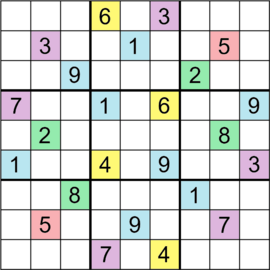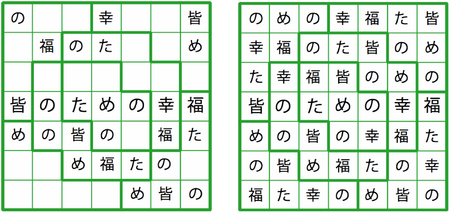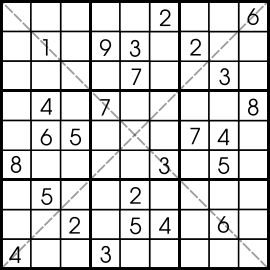Glossary of Sudoku facts for kids
A Sudoku is a fun number puzzle. This guide explains some common words and ideas you'll hear when talking about Sudoku. We'll mostly talk about the classic 9x9 Sudoku grid, unless we say otherwise.
Contents
Understanding the Sudoku Grid
A Sudoku puzzle is a grid that's partly filled in. This grid has 9 rows (going across), 9 columns (going up and down), and 9 big squares called boxes (or blocks or regions). Each of these boxes has 9 smaller squares, called cells, making 81 cells in total.
When you look at the grid, rows that are next to each other horizontally form a band. Columns that are next to each other vertically form a stack. The numbers that are already filled in when you start the puzzle are called clues or givens.
A normal Sudoku puzzle has only one correct answer. Rows, columns, and regions are all called groups. There are 27 groups in a 9x9 Sudoku. The main rule of Sudoku, sometimes called the One Rule, is simple: each number (from 1 to 9) can only appear once in each row, once in each column, and once in each box.
More Sudoku Words
- Automorphic – This is a special feature of some Sudokus. It means that the numbers themselves (not just where they are placed) create a type of symmetry in the puzzle.
- Backtracking – This is a way to solve Sudokus, either by computer or by hand. If you're solving by hand, it means you make a guess, and if it turns out to be wrong, you go back to where you guessed and try a different number. It's usually not the best way to solve, but sometimes it's needed for very hard puzzles.
- Constraints – These are the rules of Sudoku. They say that each number can only appear once in each row, column, and box.
- Element – This is just another word for a number or digit in Sudoku. You might hear this term more often for Sudokus that are bigger than 9x9, where they might use more than just numbers 1-9 (like letters or bigger numbers).
- Latin Square – This is a puzzle similar to Sudoku. It only has rules for rows and columns (each number appears once in each row and column), but it doesn't have the box rule.
- Minimal – A minimal Sudoku (also called an irreducible Sudoku) is a puzzle where you can't remove any of the starting clues without the puzzle having more than one solution. Different minimal Sudokus can have different numbers of starting clues.
- Minimum Number of Clues – This refers to the smallest number of starting clues a Sudoku can have and still have only one solution.
- Nonet – Another word for the boxes or regions in a Sudoku. In some different types of Sudoku, these "nonets" might not be square-shaped.
- Proper Sudoku – This means a Sudoku puzzle that has only one correct answer. Most Sudokus you play are expected to be "proper Sudokus."
- Region – Another word for the boxes in a Sudoku. Like "nonet," regions might not be square in some puzzle variations.
- Satisfactory Puzzle – This is a puzzle that you can solve without having to guess. (But what counts as "guessing" isn't always clearly defined!)
- Size – This describes how big a Sudoku puzzle or grid is. For example, a classic Sudoku is 9x9, or you could say it has 81 cells.
- Square – This is another word for a cell in a Sudoku. However, people often avoid using "square" to prevent confusion with the larger "boxes."
- Symmetry – The starting clues in a Sudoku can be arranged in different symmetrical ways. This means they look balanced or mirrored. Some types of symmetry include:
- 90° rotational symmetry (looks the same if you turn it 90 degrees).
- 180° rotational symmetry (looks the same if you turn it upside down).
- Reflection symmetry on one straight line (looks the same if you flip it over that line).
- Reflection symmetry on two straight lines.
- Reflection symmetry on one diagonal line.
- Reflection symmetry on two diagonal lines.
- Dihedral symmetry (a combination of rotations and reflections).
- Transformation – This is when you change a Sudoku puzzle or its grid into another puzzle that is basically the same. For example, you could swap all the 1s with 2s, all the 2s with 3s, and so on. Other transformations include swapping rows within a band, swapping columns within a stack, or flipping/rotating the whole grid. These are also called Sudoku preserving symmetries.
Different Kinds of Sudoku Puzzles
The classic 9x9 Sudoku can be changed in many ways. You can have grids of different sizes, like an N x N grid, where N is any number. In these puzzles, each of the N rows, columns, and regions must have N cells, and each of the N numbers must appear once in each row, column, or region.
Variations can also have different region sizes and shapes, like rectangular regions instead of square ones. For puzzles where N is a prime number (like 5 or 7), the regions can even be unusual shapes called polyominoes.
Other types of Sudoku might have extra rules about where numbers can go, use different symbols (like letters), or have clues given in different ways. Some even have overlapping grids.
Sudoku Types and Classes
- Sub Doku – These are Sudoku grids that are smaller than 9x9. The 4x4 version is sometimes called "Children's Sudoku" because fewer possibilities make them easier to solve.
- Super Doku – These are Sudoku grids that are larger than 9x9.
- Prime Doku – An N x N grid where N is a prime number (like 5x5 or 7x7). These often use polyomino-shaped regions.
- Maximum Su Doku – These are puzzles that need the most "independent clues" (starting numbers) to have only one solution.
- Minimum Su Doku – These are puzzles that need the fewest "independent clues" to have only one solution. These are the same as minimal Sudokus.
- Jigsaw Sudoku – A regular 9x9 Sudoku where the row and column rules still apply, but instead of 3x3 boxes, the regions are nine different "jigsaw" shapes.
Sudoku Variants by Size
- Polyomino – A shape made of equal-sized squares joined side-to-side. These are often used for the regions in different Sudoku types. Polyominoes are named by how many squares they have: (5) pentomino, (6) hexomino, (7) heptomino, (8) octomino, and (9) nonomino.
- Du-sum-oh – These puzzles come in sizes like 5x5, 6x6, 7x7, 8x8, or 9x9. They have irregular, polyomino-shaped regions and the smallest number of clues possible. They are also known as Squiggly Sudoku, Jigsaw Sudoku, or Irregular Sudoku. The regions are made of the same number of squares as there are rows in the puzzle.
- 4x4 – Called Shi Doku. It has four 2x2 regions. "Shi" means 4 in Japanese.
- 5x5 – Called Go Doku or Logi-5. It's a 5x5 grid with pentomino regions. "Go" means 5 in Japanese.
- 6x6 – Called Roku Doku. This version was used in the World Puzzle Championship. It has six 2x3 rectangular regions.
- 7x7 – An unnamed version with six heptomino regions and one separate region, also featured at the World Puzzle Championship.
- 8x8 – Sometimes called Super Sudoku X. It has four 4x2 blocks and four 2x4 blocks.
- 9x9 –
- Sudoku: This is the classic 9x9 grid.
- Sudoku X: This adds an extra rule: the numbers along both main diagonal lines must also be unique (no repeats).
- Jigsaw Sudoku: A 9x9 grid with nonomino regions (regions made of 9 squares in a jigsaw shape).
- 12x12 – Called Maxi. It has twelve 3x4 rectangular blocks.
- 16x16 – Called Number Place Challenger. It has sixteen 4x4 regions.
- 25x25 – Called Sudoku the Giant. It has twenty-five 5x5 regions.
- 100x100 – Called Sudoku-zilla. It has 100 10x10 regions.
Sudoku Variants with Extra Rules
Some Sudoku puzzles have extra rules about where you can place numbers. These might include rules about numbers being greater or less than others, sums of numbers in certain areas, or connections between cells.
- Hypersudoku – This puzzle has extra 3x3 boxes added inside the main grid, which also need to follow the Sudoku rules.
- Main Diagonals Unique – As in Sudoku X, the numbers along both main diagonal lines must be unique (no repeats).
- Relative Digit Location – In these puzzles, certain numbers must be in the same relative spot within specific regions. These matching cells or regions are often shown with colors.
- Killer Sudoku (Clue Sums) – These puzzles have regions of different shapes and sizes. The usual rules (no repeats in rows, columns, or regions) still apply. But the clues are given as the sum of the numbers within these special regions. For example, a 4-cell region that sums to 10 must contain the numbers 1, 2, 3, and 4 in some order.
- Sandwich Sudoku – In this puzzle, numbers outside the grid tell you the sum of the digits in a row or column that are "sandwiched" between the '1' and the '9'.
Words for Solving Sudoku
These terms help describe different ways to solve Sudoku puzzles.
- Scanning – This is when you carefully look through the puzzle to find numbers or rule out possibilities.
- Cross Hatching – A way to eliminate numbers. You check the rows and columns that cross a box to see where a certain number can't go in that box.
- Counting – This means going through the numbers for a row, column, or box to see which numbers are missing or where they can be placed.
- Box Line Reduction Strategy – A method where if a number must be in a certain row or column, you can remove that number as a possibility from any cells in a box that also crosses that row or column.
- Candidate – A possible number that could go into a cell.
- Contingency – A condition that limits where a number can be placed.
- Chain – A series of connected "contingencies" that show how different possibilities are linked.
- Independent Clues – A set of starting numbers that can't be figured out from each other.
- Intersection Removal – If a number can only go in one or two spots within a row, column, or box, you can remove that number as a possibility from other cells where that row, column, or box overlaps with another group. This is sometimes called Pointing Pairs/Triples.
- Nishio – A "what-if" solving method. You try placing a number, and if it makes it impossible to place other necessary numbers, then your initial guess must be wrong.
- Single (or singleton, or lone number) – This is when a cell has only one possible number that can go in it.
- Hidden Single – A number that seems to have other possibilities in a cell, but when you look at the whole row, column, or box, it's the only place that number can go.
- Locked Candidate – A number that can only go in a specific row or column within a single box.
- Naked Pair – Two cells in a row, column, or box that can *only* contain the same two numbers. Once you find these, you can remove those two numbers as possibilities from all other cells in that same row, column, or box.
- Hidden Pair – Two numbers that can only appear in two specific cells within a row, column, or box. You can then remove any other possible numbers from those two cells.
- Trio – Three cells in a group that share only three specific numbers.
- Triples and Quads – The same ideas as Naked and Hidden Pairs can be used for three numbers (triples) or four numbers (quads).
- X-wing – See N-fish (when N=2).
- Swordfish – See N-fish (when N=3).
- N-fish – These are more advanced patterns, similar to hidden pairs/triples/quads, but they involve multiple rows and columns. An N-fish is a pattern where all the possible spots for a certain number in N rows (or columns) are found in only N columns (or rows). This means you can remove that number as a possibility from other cells in those N columns (or rows).
- 2-fish: Called an X-wing.
- 3-fish: Called a Swordfish.
- 4-fish: Called a Jellyfish.
- 5-fish: Sometimes called a Squirmbag. In a 9x9 Sudoku, a 5-fish is always linked to a 4-fish (Jellyfish) that has the same effect.
- Remote Pairs – When you have a long chain of Naked Pairs connected across the grid, any cells that are at the start and end points of this chain cannot contain either of the numbers in those Naked Pairs.




